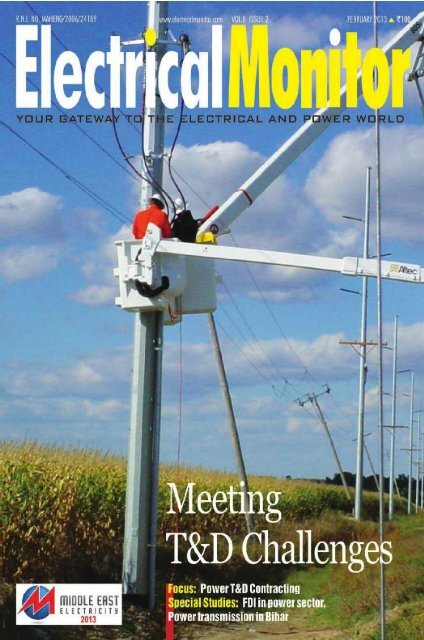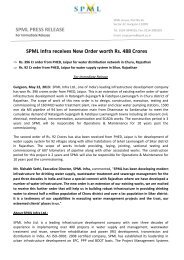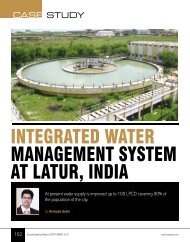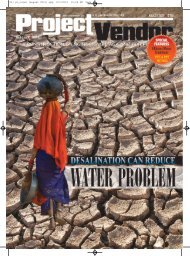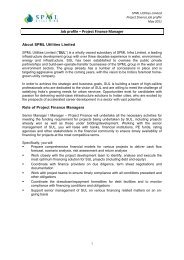Meeting T&D Challenges - SPML
Meeting T&D Challenges - SPML
Meeting T&D Challenges - SPML
- No tags were found...
Create successful ePaper yourself
Turn your PDF publications into a flip-book with our unique Google optimized e-Paper software.
Interview‘Set up in 1981, <strong>SPML</strong> Infra Ltd is a leading infrastructuredevelopment company with multi-disciplinary experience in watertreatment and transmission, municipal solid waste management,power projects and civil infrastructure construction. We haveRishabh Sethi discussing activities of the company’s power SBU.Sethi, while proudly noting that <strong>SPML</strong> has helped illuminate over amillion rural households through village electrification contracts,discusses the prospects and challenges of the power T&Dcontracting business. An interview by Venugopal Pillai.T&D is more of managementintegration than just production— Rishabh Sethi,Executive Director, <strong>SPML</strong> Infra Ltd‘At the outset, please summarize the gamut of activitiesundertaken by <strong>SPML</strong> Infra in the field of EPC contracting in thepower T&D sector.<strong>SPML</strong> is one of the largest contributors of rural electrificationin India and power transmission & distribution projects formsmore than 50 per cent of <strong>SPML</strong>’s initiatives in the power sector.Over a million rural households across the country havebenefited through our power generation, transmission anddistribution works. We are equipped with latest technology andexecuting projects of up to 400kV transmission lines, 400kV ofsubstations, underground cabling, over half a million BPLconsumer connections, LT/HT lines and feeder separations,SCADA and PLC among others.Rural Electrification inRohtas, BiharHow is India’s power sector shaping up?The robust economic growth and rapid urbanization has puthuge pressure on India’s infrastructure. Power, water, roads,sewers are critical infrastructure components that ensuresocioeconomic development of a country. Among these, thepower sector plays a significant role but it still lags behinddespite the introduction of progressive measures. Marketanalysis suggests that even if India continues to grow at anaverage rate of 8 per cent for the next 10 years, the country’spower demand is likely to grow from the present 120 GW to315-335 GW by 2017, which would be 100 GW higher than thecurrent growth rate, an outstanding shortage.<strong>SPML</strong> Infra has been doing a large number of contracts relatingElectrical Monitor February 2013 61
Focus: Power T&D ContractingSubstation at Ramgarh, Rajasthanto rural electrification. Tell us about the company’sachievements in this sector.Yes, <strong>SPML</strong> has executed a large number of rural electrificationprojects for various power utility companies and implementingagencies all over the country.<strong>SPML</strong> has completed one of the most challenging projects ofrural electrification in villages on Jhumra Hill, some 80 km fromBokaro district in Jharkhand. The topography of the area andextreme Maoist activities have forced villagers to live apathetic life as development has not reached there. There wasno road to connect these villages to outside world andelectrification of these villages across dense forest was anuphill task. <strong>SPML</strong> took up the challenge and in the absence ofroad; our people had to climb the hill carrying heavy concretepoles and wires on their shoulders and installed more than 600electricity poles, 6 transformers and substations and thehouseholds were provided with electricity connections. <strong>SPML</strong>has been working for rural electrification for over threedecades now and illuminated lives of millions of people in ruralIndia!In the field of power transmission, we understand that <strong>SPML</strong>Infra undertakes projects up to 220kV. Do you have plans ofenhancing your capabilities to higher voltages?We have already started upgrading our facilities to execute400kV transmission line projects and are planning to enhanceour execution capability to 765kV in near future.Given that India is expected to invest around Rs.7 trillion in itspower T&D sector in the XII Plan period, how do you gaugebusiness prospects?Some strategic measures have been taken including theElectricity Act 2003 and the policy landscape has progressivelyevolved that have led to radical changes in the power sector,especially in terms of competition. We have seen private sectorinvolvement and focus on green energy over the last decade.Till early 1990s, the power sector was safeguarded from anyprivate sector involvement; however, the mounting pressureon Government resources to support capacity additions,repeated delays encountered by state utilities and the growingdemand supply gap urged the Government of India to open thepower sector to private participation along with country’sglobalization policy.The plan to invest around Rs.7 trillion in power T&D sector inthe XII Plan is a welcome move and in the right direction. <strong>SPML</strong>has very good experience in transmission & distribution and isenhancing the capabilities to execute large and complex62 Electrical Monitor February 2013
Focus: Power T&D Contractingprojects all over the country. Apart from the existing projects,<strong>SPML</strong> has been short-listed as the lowest bidder for differentT&D projects worth over Rs.1,000 crore and more projects arein the pipeline. We are a preferred partner for power utilitycompanies and state electricity boards and we expect toreceive more projects during this XII Plan period.When it comes to Central or state government-owned utilities,do you observe any change in the policy framework of awardingcontracts, over the years?Electricity is a concurrent subject in India; both the Central andstate governments are responsible for the development of thissector. It is regulated with the Central Electricity RegulatoryCommission at the Centre and State Electricity RegulatoryCommissions at state levels. The issue of awarding contractsand making it feasible to execute remains the same with bothCentre and state. Land is a basic necessity for powergeneration projects. A lot of projects are either cancelled ordelayed due to non-availability of land or difficulties in landacquisition. Another major hurdle post identification andselection of land is securing the required clearances frommultiple government ministries and agencies. Centre-awardedprojects have an upper hand of getting these clearances a littlefaster than the states as there are other local issues thatsometimes take precedence.The delay in awarding the project after submission of tenderincreases the execution cost due to escalation of prices ofmaterials and manpower. Utilities may avoid such delay for thebetter and timely execution of the project. Even the delay inclosing the contract after the completion of project putsundue pressure on execution companies as their finalpayments get delayed.<strong>SPML</strong> is executing a number of projects for hydropowergeneration with a combined capacity of 125 mw in HimachalPradesh and Mizoram. <strong>SPML</strong> has the capabilities of completesystem integration of power plants, detailed power plantengineering with the various auxiliaries and equipment in theBOP package and transmission and distribution.We have a very strong engineering team in place which isfully capable to handle any project of any size. We have astrategic plan to increase our presence in water and powersectors in the next 3-5 years and make <strong>SPML</strong> as the largestplayer in the urban utility services in India.What has been your experience with manpower availability,both skilled and semi-skilled, for execution of power T&Dcontracts?Power T&D projects are a manpower run business; not justproduction but management integration. In the presentcompetitive market scenario, there is a huge gap in skilledand experienced workforce. It is a challenge to execute theprojects on time in the absence of both skilled and semiskilledworkforce. <strong>SPML</strong> has been training people to takebigger responsibilities and it is paying us in the long run.What are the typical challenges that you face whileexecuting power distribution contracts, like RGGVY and R-APDRP, in rural India?There are some social reasons like opposition fromresidents due to concerns over loss of land, resettlementand rehabilitation issues; environmental issues likeafforestation apart from lack of skilled work force,educating villagers about the project and delays in startingthe project due to other local reasons.Please summarize the way forward for the power SBU overthe next 5-7 years.<strong>SPML</strong> has successfully delivered a number of powergeneration, transmission & distribution projects. Presently,Electrical Monitor February 2013 63


